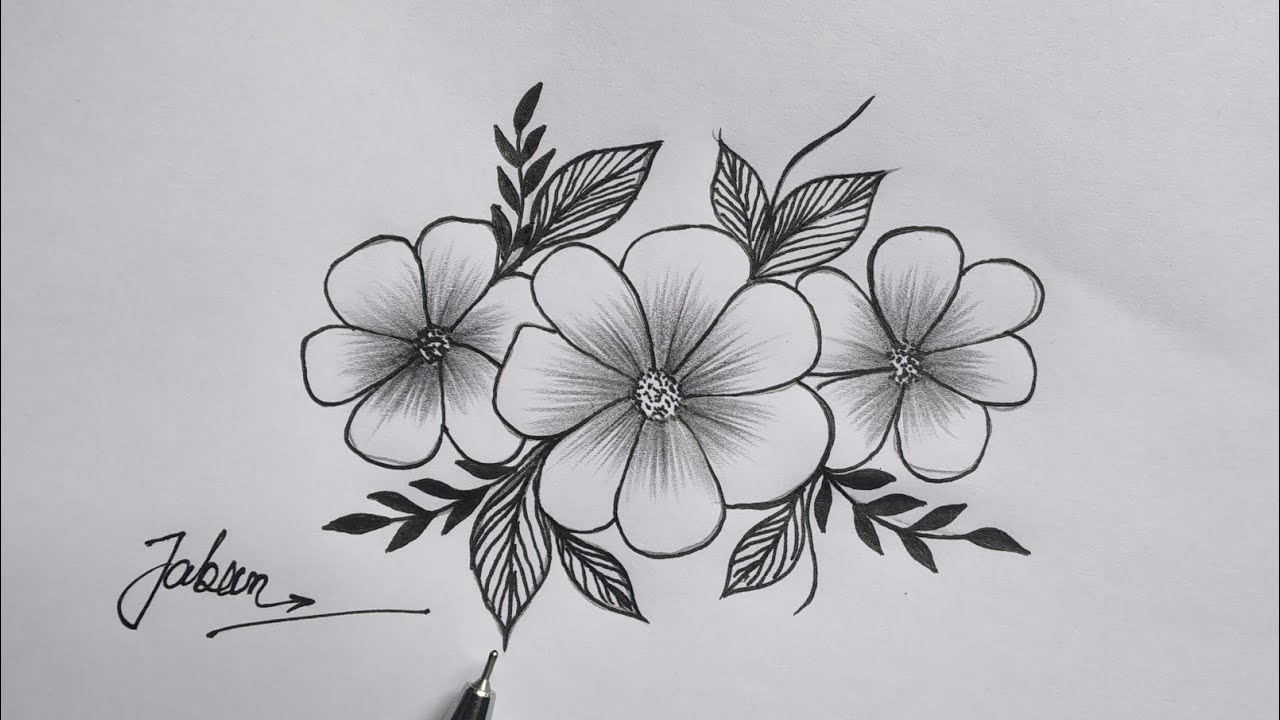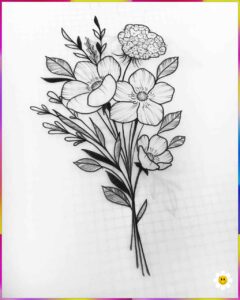
Introduction to Flower Drawing
Flower drawing is a commendable form of artistic expression that has captivated the interests of artists for centuries. Its significance lies not only in its aesthetic appeal but also in its therapeutic benefits, which make it increasingly popular among individuals of all skill levels. Whether you are a seasoned artist or a beginner, engaging in flower drawing can offer a sense of tranquility and mindfulness, allowing one to focus on the intricate details of nature.
One of the most appealing aspects of flower drawing is its accessibility. Many may perceive drawing as a complex endeavor; however, the beauty of flowers can be captured in ways that are both simple and elegant. The phrase “flower drawing easy and beautiful” aptly describes the style in which one can approach this art form. With the right techniques and a touch of practice, artists can create stunning representations of flowers that evoke appreciation and admiration. Furthermore, drawing flowers allows individuals to enhance their observational skills, as they learn to notice subtle variations in color, shape, and texture.
In addition to artistic improvement, flower drawing is known to stimulate creativity. As one explores different forms of flowers, the process itself can spark new ideas and encourage experimentation with various colors and compositions. To embark on this artistic journey, a few basic materials are needed. These include high-quality drawing paper, graphite pencils, erasers, and colored pencils or watercolors for those looking to add a splash of vibrancy to their artwork. With just these tools at hand, anyone can begin their exploration of flower drawing. As you delve into the world of flowers, you will find that this delightful endeavor not only nurtures your creative spirit but also provides a rewarding and enriching experience.
Basic Techniques for Flower Drawing
Creating flower drawings that are both easy and beautiful requires a solid understanding of fundamental techniques. The first step in mastering flower drawing is developing your sketching skills. Begin by practicing simple line work, which serves as the foundation for your drawings. Use light pencil strokes to outline the basic shape of the flower. Focus on capturing the overall silhouette before diving into the intricate details. This preliminary stage is essential in establishing proportions and symmetry, which are crucial for a realistic representation.
Shading is another important aspect to consider in flower drawing. By varying the pressure applied to your pencil, you can create depth and dimension in your artwork. Observe how light interacts with the petals and leaves of flowers in real life. This observation will enhance your ability to replicate their natural beauty on paper. Start with soft shading for a light effect and gradually build up darker tones to highlight shadows. Experimenting with different techniques, such as cross-hatching or stippling, can also add variety to your shading process.
While realistic drawings are often preferred by beginners, embracing stylized approaches can also yield stunning results. As you progress, consider how different styles impact the representation of flowers. For instance, some may choose to emphasize vibrant colors over accurate shapes, resulting in artistic expressions that are equally beautiful. Ultimately, the technique you select should align with your artistic goals and personal style.
To further develop your skills, engage in practice exercises that focus on drawing various flower types. Start with straightforward forms, such as daisies or tulips, and gradually challenge yourself with more complex varieties. These exercises will help solidify your understanding of proportions, shapes, and shading techniques, reinforcing your ability to create flower drawings that are not only visually appealing but also reflective of your creative vision.

Step-by-Step Flower Drawing Tutorial
Creating an easy and beautiful flower drawing is an enjoyable endeavor that can be approached methodically. For this tutorial, we will focus on drawing a simple rose, which embodies elegance and beauty. Follow these steps to guide you through the drawing process.
Begin by outlining the basic shape of the rose. Start with a small circle for the center of the flower. This circle will be the focal point around which the petals will grow. Next, sketch a loose spiral emanating from this circle, which will represent the inner petals. It is essential to keep the lines light at this stage; refining can be done later.
Next, we will add the outer petals. From the outer edge of the spiral, draw larger petal shapes that curve outward. Make sure to vary the size and curvature of the petals to create a more natural appearance. Remember to consider perspective; the petals in the foreground should be slightly larger than those retreating into the background.
Once you have your petal shapes delineated, it’s time to adjust the outlines. Using a finer pencil or pen, go over the contours of each petal to give them definition. Pay attention to the gentle curves and tips of the petals, as these details contribute to the flower’s beauty. In this step, you can also add small lines to indicate the delicate texture of the petals.
Now, move on to the leaves. Draw a few elongated ovals around the base of the flower, incorporating symmetrical shapes to represent the leaves. Adding subtle serrated edges to the leaves provides a realistic look. When drawings are complete, you can use colored pencils or watercolors to fill in your flower, selecting colors that reflect the natural beauty of a rose—think deep reds or soft pinks.
By following these steps, beginners can master the art of flower drawing easy and beautiful while developing their skills and confidence in creating stunning floral artwork. With practice, you can create your unique interpretations, exploring different flowers and techniques at your leisure.
Adding Color and Finishing Touches
Coloring your flower drawing can be an exhilarating experience, transforming a simple sketch into a vibrant piece of art. Various mediums, such as colored pencils, watercolors, and markers, each offer their unique characteristics and results. By choosing the medium that best suits your style, you can enhance the beauty of your flower drawing in an easy and beautiful way.
When using colored pencils, consider employing techniques such as layering and blending. Start with lighter shades and gradually build up darker colors, allowing you to create depth and dimension in your petals and leaves. A gentle circular motion can help in the blending process, resulting in a more natural transition between hues. For those utilizing watercolors, the key lies in mastering the wet-on-wet and wet-on-dry techniques, which can produce intricate blends and added texture, elevating the overall aesthetic of your flower drawing and How To Earn Money Online WIth Zero Investment.
Markers can also be an excellent choice for achieving vibrant results. When using alcohol-based markers, work in layers to prevent overwhelming the paper with too much color at once. Utilize the colorless blender to soften harsh lines, creating a smooth look. Combining different mediums, such as colored pencils over marker, can add depth and intricacy to your flower drawings, making them more appealing and distinctive.
Upon completing your artwork, consider adding a few final touches, such as highlights using a white gel pen or some shadowing with darker shades. These details can dramatically enhance the lifelike quality of your drawing. Finally, when showcasing your masterpiece, consider framing it behind glass to protect it from damage and dust. Your flower drawing is now not only an expression of creativity but also a beautiful representation of your artistic journey, inviting you to explore further and embrace your unique style.





